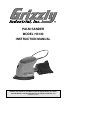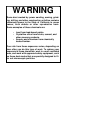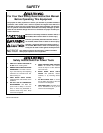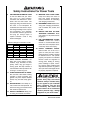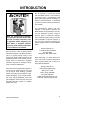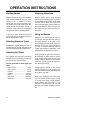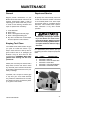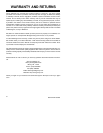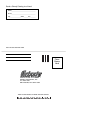
H3120 Palm Sander
OPERATION INSTRUCTIONS
Starting Sander
Plug the cord into a 110V outlet. Move the
black switch (located at the front of the
sander) to the “–” position to turn the
sander ON, and move the switch to the
“O” position to turn the sander OFF. The
sander should run smoothly. Strange or
unnatural noises should be investigated
and corrected before operating further.
If you cannot easily locate the source of
an unusual noise or vibration, contact our
service department for help.
Selecting Abrasive Types
ALUMINUM OXIDE abrasives are an
excellent choice because they last longer
and are sharper than natural abrasives.
Selecting Grit Sizes
As a general rule, start with a coarse grit
size and move through finer grit sizes until
you achieve your desired results.
Use the list below to define paper grit
sizes:
• Extra Coarse..............................12-20
• Very Coarse ..............................24-36
• Coarse ......................................40-50
• Medium ....................................60-100
• Fine........................................120-180
• Very Fine ..............................220-280
• Extra Fine ..............................320-400
Attaching Abrasives
Abrasive sheets can be easily attached
with the hook-and-loop system on the pad
of your Model H3120 sander. Fit the sheet
over the pad so that it covers the entire
area, push and slightly twist to make sure
the coated abrasive sheet is snug on the
pad. Make sure you don’t cover the suc-
tion holes.
Using the Sander
Determine the appropriate grit size for
your project and sand the work evenly in
the same direction as the grain of the
wood. Always keep the sander moving so
the finish of your work stays consistent. If
you stay in one place too long, then the
sander may produce a depression in the
wood that will compromise your finish.
Sanding across the grain of the wood may
be necessary in some cases to remove
rough defects. This should be done with
caution, however, because it can produce
cross-grain scratching that will require fur-
ther sanding to remove.
Change abrasive sheets as soon as the
grit becomes dull. You will recognize this
when the sander seems to slide across the
work without any “bite.”
Never apply excessive force while sand-
ing. Your sander will last longer if you let
“it” do the work. Using a slight pressure
barely greater than the weight of the
machine is ideal because you can still
maintain control while obtaining a fine fin-
ish.
-4-



